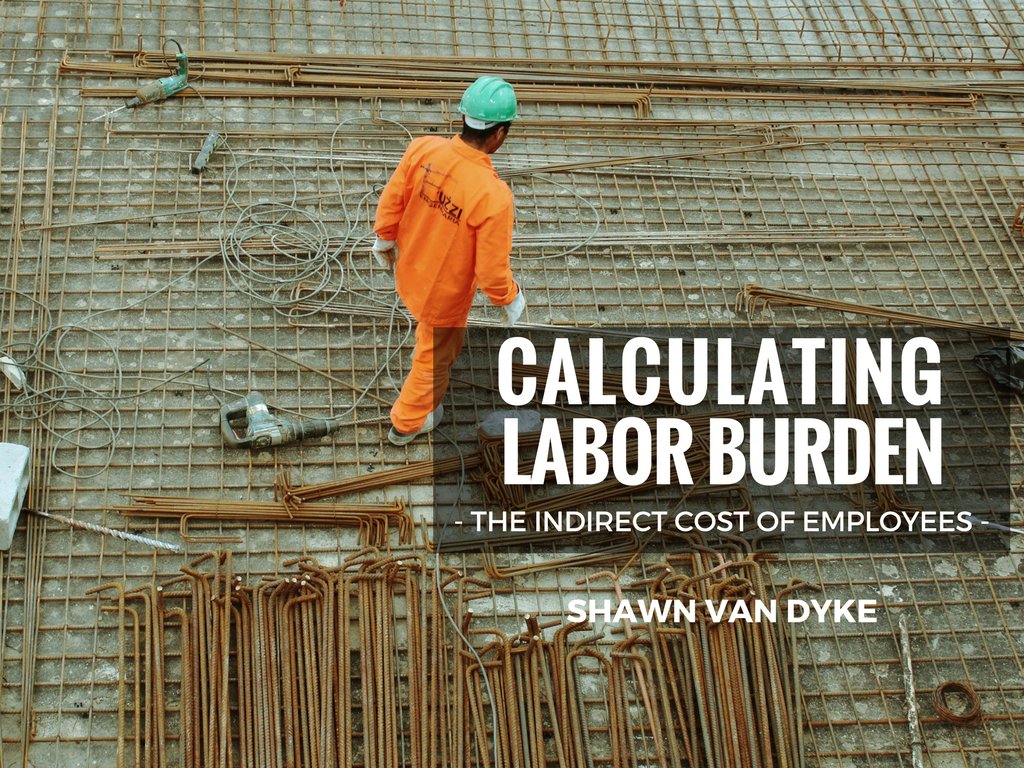Built to Build: Blog
Calculating Labor Burden for Your Construction Business

Not accounting for the labor burden in a construction estimate can come at a very heavy price. The labor burden is determined by the indirect costs of employing someone. If these “hidden” costs aren’t accounted for, then each project you perform could put you further and further out of business.
To avoid working yourself out of business and get beyond just breaking even, you must understand what your labor burden is and how to calculate it.
In this article at FineHomebuilding.com, I show you how to calculate the labor burden for your construction business.
CALCULATING THE LABOR BURDEN
Labor costs are broken into two categories—direct and indirect. Calculating the accurate total labor costs for a construction business involves adding the indirect costs to the direct costs of labor.
The direct cost for an employee is the wage paid to that employee.
The indirect costs for an employee depend on many variables, and these variables will be unique for each construction business. The indirect costs for labor include any and all costs associated with employing a person in the business. These indirect costs include, but are not limited to:
- Worker’s Compensation
- General Liability
- Vehicle Insurance
- Communication Expenses
- Employee benefits (health, retirement, profit-sharing programs)
- Vacation and/or holiday and sick pay
- Payroll taxes
- Training and Employee Development
- Company Apparel
The LABOR BURDEN for a construction business is the total of all the indirect labor costs expressed as a percentage of the direct labor costs. (See this post for a FREE LABOR BURDEN CALCULATOR.)
INDIRECT COSTS / DIRECT COST x 100% = LABOR BURDEN %
In other words, for every dollar you pay an employee, you will also have to pay a certain amount to employ that person.
DETERMINING THE LABOR BURDEN
Locating and calculating all the indirect costs in your construction business is the most difficult part of determining your LABOR BURDEN, but it is a necessary chore to realize the margins required to make your numbers work.
Contact your CPA or tax professional to help you determine the exact indirect costs for your business.
Let’s assume that we have identified the indirect costs for our company, and are going to develop the LABOR BURDEN factor for an employee named Tim.
Tim is paid $20/hr.
START WITH TIME
Tim is a full-time employee and is employed to work 40 hours per week for the entire year.
Tim works:
40 HR/WK x 52 WK/YR = 2080 HR/YR – TOTAL WORKING HOURS
Tim’s compensation is:
$20/HR x 2080 HR/YR = $41,600/YR
1. Determine the cost for which Tim is paid but does not work:
– 6 Holidays (New Year’s Day, Memorial Day, July 4th, Labor Day, Thanksgiving Day, Christmas)
6 HOLIDAYS x 8 HR/DAY = 48 HRS
– 5 Vacation, Sick, or Personal Days – Paid Time Off (PTO)
5 Days PTO x 8 HR/DAY = 40 HRS
– 2 Training Days – Seminars or Professional Development
2 Days Training x 8 HR/DAY = 16 HRS
2. Calculate Tim’s available working hours:
TOTAL WORKING HOURS – PAID LEAVE = TOTAL AVAILABLE WORKING HOURS
2080 – 48 HOLIDAYS – 40 PTO – 16 TRAINING =
1976 TOTAL AVAILABLE WORKING HOURS
3. Calculate the General or Administrative Time Tim spends on non-billable/production work. This time could be related to company meetings, company maintenance (shop/field), time reporting, etc.
Let’s assume that of the TOTAL AVAILABLE WORKING HOURS calculated above, Tim spends 2 hours per week on these General or Administrative tasks.
4. Divide the TOTAL AVAILABLE WORKING HOURS by 40 HRS/WK to determine the number of effective weeks Tim is available to work.
1976 HR / 40 HR/WK = 49 WK (rounded down)
General/Admin Time = 2 HR/WK x 49 WK/YR = 98 HR/YR
5. Determine the TOTAL PRODUCTION HOURS Tim can work by subtracting the TOTAL General/Admin Time from the TOTAL AVAILABLE WORKING HOURS:
1976 – 98 = 1878 TOTAL PRODUCTION HOURS
If we were to stop here, then we could determine a LABOR BURDEN factor based on the TOTAL PRODUCTION HOURS versus the TOTAL WORKING HOURS.
Tim is going to receive pay for 2080 hours which totals $41,600 (assuming he receives all the PTO offered and other time listed above).
But Tim is only producing work for 1878 hours in a given year.
If we divide Tim’s TOTAL WORKING HOURS by his TOTAL PRODUCTION HOURS, then we get the LABOR BURDEN factor we need to apply to his pay rate to determine the ACTUAL LABOR COSTS (including this LABOR BURDEN).
TOTAL WORKING HOURS / TOTAL PRODUCTION HOURS = LABOR BURDEN FACTOR
2080 / 1878 = 1.11
Tim’s Labor Cost Rate per hour is approximately 11% more than his wage or:
WAGE $/HR x LABOR BURDEN FACTOR = $20/HR x 1.11 = $22.20/HR
But we can’t stop here. There are more costs to employing Tim that we must include.
INCLUDE INDIRECT COSTS
Listed below are some* of the indirect costs that should be included in any LABOR BURDEN calculation.
- Payroll Taxes $3744 (Based on effective overall rate of 9% – varies by state)
- Worker’s Compensation $4160 (assumes 10% rate or $10 per $100 payroll)
- Uniforms (shirts, hats, etc.) $200
- Tool Allowance/Maintenance $600 (based on $50/month)
- Company Events $240 (based on $20/month – picnics, parties, other events)
- Bonus, Cost of Living, Raises $1248 (based on 3% of wages)
- Professional Development $175 (fees for training, seminars, education)
- Health Insurance Reimbursement $1500 (based on $125 per month reimbursement)
*This is by no means a comprehensive list. Other items that may be included here are retirement benefits, use of a company vehicle, mobile devices, etc.
The total for the indirect costs listed above is $11,867.
If Tim’s total compensation is $41,600 based on a $20/HR wage, then we need to add the $11,867 of indirect costs to this number to determine the total cost to employ Tim.
TOTAL COST TO EMPLOY TIM:
$41,600 + $11,867 = $53,467
Now we can determine the effective cost rate of Tim per hour including the TOTAL PRODUCTION HOURS:
TOTAL COST TO EMPLOY / TOTAL PRODUCTION HOURS = $53,467 / 1878 = $28.47/HR.
Therefore the LABOR BURDEN FACTOR is:
$28.47 / $20 = 1.42.
In other words, for every dollar you pay Tim, it will cost you $0.42 in additional indirect costs.
This 42% in additional costs does not include the MARKUP on Tim’s labor. This in only the breakeven number.
In order to determine the price at which you should sell Tim’s labor you need to understand the markup your business needs to make the margin that is required.
(See my previous post about Markup and Margin here.)
THE FINAL PRICE
Let’s assume you determine your markup to be 50%. Then you would calculate the price for an hour of Tim’s labor with the following equation:
LABOR WAGE x LABOR BURDEN FACTOR x MARKUP = LABOR PRICE
$20/HR x 1.42 x 1.5 = $42.60/HR
Google “definition of burden” and this is the result:
Bur·den – noun – a load, especially a heavy one.
Understanding how to calculate your labor burden will cause you to experience the opposite of the word burden—relief.
Re·lief – noun – a feeling of reassurance and relaxation following release from anxiety or distress.
Now doesn’t that sound nice?
If you want to streamline your construction business and DOUBLE your profits next month…
download my FREE book: The Paperwork Punch List

